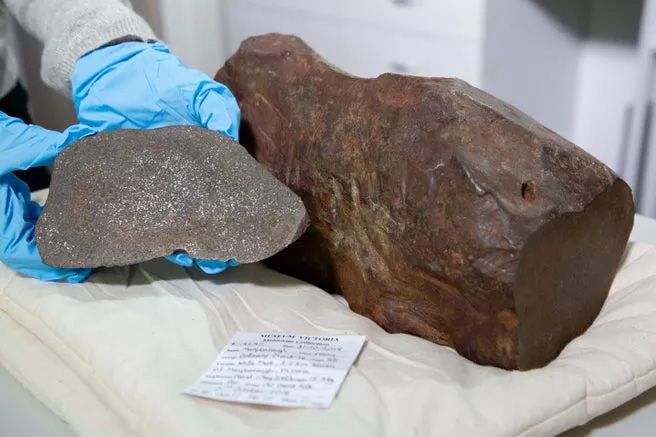An extraordinary treasure has left an Australian man bewildered, as he struggled to break it open with a rock saw, drill, sledgehammer, and even acid, ultimately deciding to bring it to scientists, where he was completely shocked by the findings.
According to Science Alert, David Hole discovered a heavy red rock embedded in some yellow clay while using a metal detector at the Maryborough Regional Park near Melbourne, Australia.
He took it home and eagerly opened the rock, believing it must contain gold inside. However, despite all kinds of tools and even acid, the rock remained unyielding. Doubting the strange phenomenon, he brought it to scientists after years of keeping it.

Extraterrestrial treasure found in Maryborough – (Photo: MELBOURNE MUSEUM)
In a study recently published in the Proceedings of the Royal Society of Victoria, scientists revealed that it is a treasure from the dawn of the Solar System, even older than Earth: 4.6 billion years old.
Geologist Bill Brich from the Melbourne Museum explained to the Sydney Morning Herald that this rock is significantly heavier than similar rocks found on Earth.
They had to use a diamond saw to cut a small slice of this cosmic treasure, discovering that it contains a high iron content, along with tiny crystalline metal mineral droplets scattered throughout.
This treasure is expected to help scientists “travel back in time” to find clues about the formation and chemical composition of the early Solar System.
Although they have not confirmed where the meteorite originated or when it landed on Earth, scientists speculate that it belongs to the asteroid belt between Mars and Jupiter today, having been ejected far away in a violent planetary collision billions of years ago.
Radiocarbon dating of surrounding materials suggests it may have landed between 100 to 1,000 years ago.
This is one of 17 unique meteorites ever recorded in the state of Victoria, Australia, and is the second largest meteorite by mass, following another massive specimen weighing 55 kg that was identified in 2003.
Meteorites from the dawn of the Solar System are highly sought after by scientists worldwide, who spend significant amounts of money in search of them. NASA and JAXA (the space agencies of the United States and Japan) have invested hundreds of millions of dollars to travel to ancient asteroids, collecting samples in hopes of answering eternal questions about the origins of Earth and ourselves.


















































